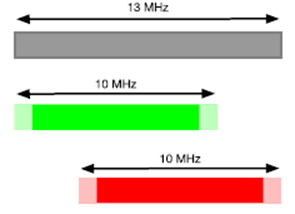Content for TR 38.844 Word version: 18.0.0
6.6 Legacy UE impact
6.6.2 Overlapping UE CBW from Network Perspective
6.6.3 Combined UE CBW (one cell)
...
...
6.6 Legacy UE impact p. 30
6.6.1 Void
6.6.2 Overlapping UE CBW from Network Perspective p. 30
Overlapping channels from the network perspective works with all the legacy UEs. As presented in previous sub-clauses, from an individual UE perspective, this is just a standard Rel-15 channel and no special UE side enhancements are needed. Thus an operator can use this solution with the whole ecosystem of available devices.
6.6.3 Combined UE CBW (one cell) p. 30
- No impact to legacy UEs. UEs which support this solution would be reconfigured in RRC_CONNECTED, there is no change to UE behaviour in IDLE mode which could create potential issue with legacy UE compatibility

Figure 6.6.3-1: Legacy UE may be configured for either of the two carriers
(⇒ copy of original 3GPP image)
(⇒ copy of original 3GPP image)